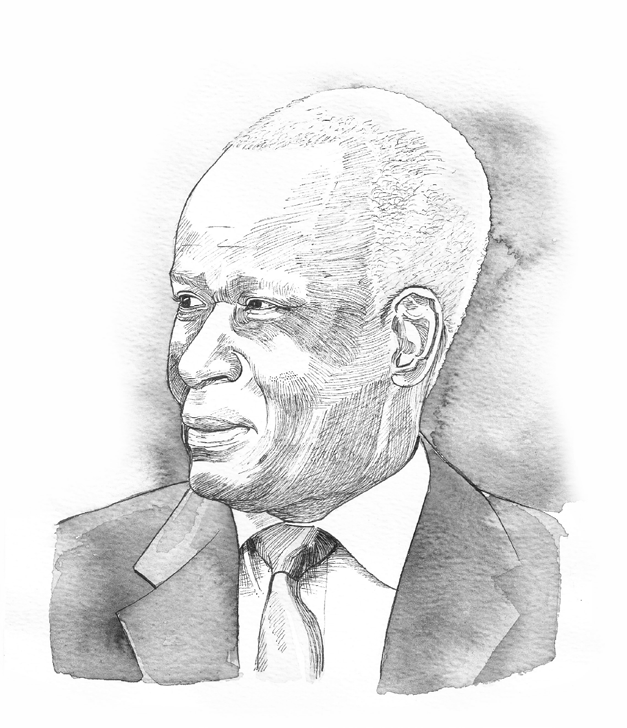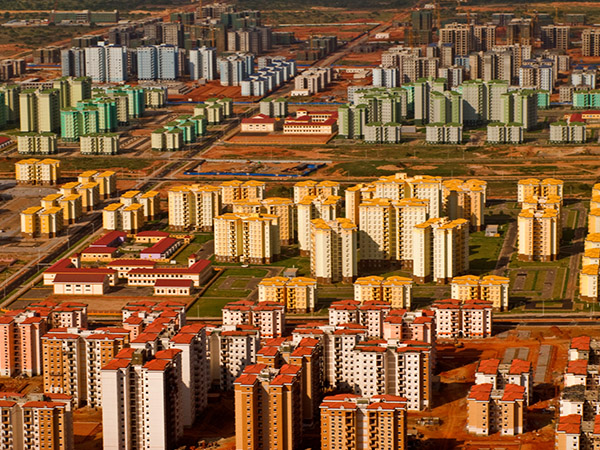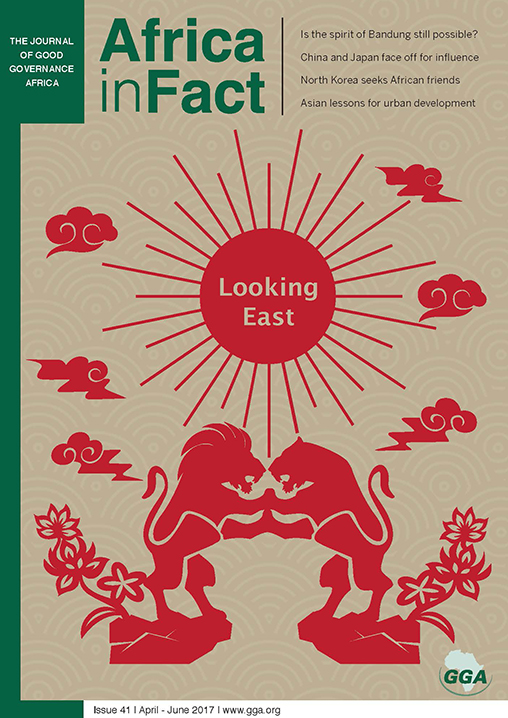
The near-empty Chinese-built city of Kilamba in Luanda Province, Angola in 2011 © Wikimedia Commons
While new metropoles sprouting across China remain empty, those they’ve built in Angola are housing the African nation’s growing middle class
China’s construction boom has seen spanking new “ghost cities” sprout up across China in an effort to boost GDP. And fears that it would also leave similar Chinese metropoles littered across Africa have been somewhat laid to rest by the rise of an African middle class.
The first two Chinese-built cities in Africa are in Angola and South Africa: of the estimated one million Chinese who have settled on the continent, 259,000 live in Angola and 350,000 in South Africa, according to Adjunct Prof. Yoon Jung Park from the African Studies Program at Georgetown University in Washington DC.
In a 2016 report for Habitat International, a number of United States (US) academics led by Robert M. Buckley wrote: “Over the past decade there has been a sudden, extraordinarily large, and simultaneous expansion of multi-billion dollar housing subsidy programs in many developing and emerging economies. All of the so-called BRICS – Brazil, Russia, India, China, and South Africa – as well as Angola … the Democratic Republic of Congo, Ethiopia [and] Rwanda – have initiated new large-scale housing programs.”
China’s strangest ghost city, Ordos Kangbashi, sprang up implausibly in the Inner Mongolian desert in 2002. Designed to cater for two million people, by April last year Kangbashi had only 100,000 residents, and it had not yet even been recognised as a city by Beijing. Analysts say that provincial governments built the ghost cities mainly to drive up their contribution to GDP. Meanwhile, 700 million Chinese still live on under US$2 per day.
China’s largest construction projects in Africa are the five “new cities” in Angola around Luanda: Kilamba (by CITIC Construction for US$3,5 billion); Cacuaco (by China Tiesiju Civil Engineering for US$704 million); and Capari, Zango, and Km 44 (by China Guangxi International Construction Engineering for US$294 million, US$184,8 million, and US$82,7 million respectively). (The figures, cited by Dr Sylvia Croese of the University of Cape Town in a 2016 study, are for the engineering, procurement and construction contracts, excluding the project management and monitoring contracts.) Situated 20 km outside Luanda’s CBD, Kilamba was the first to turn sod; it was designed to house 500,000 people in 750 apartment blocks serviced by 12 schools and more than 100 retail units.
“The project was taken over in 2008 by CITIC Construction, a subsidiary of the state-owned CITIC Group, and financed by the Industrial and Commercial Bank of China (ICBC),” Dr Ana Alves, from the Global Powers in Africa Programme at the South African Institute for International Affairs, wrote in an April 2014 policy briefing, with the Sorbonne’s David Bénazéraf.
“The pay-out of the Chinese loans is structured to bypass the Angolan government, with the Chinese banks paying the Chinese construction firms [CCFs] in China directly. The reimbursement of the loans is guaranteed by oil sales to Unipec, the trading subsidiary of the Chinese oil firm Sinopec. Angolan oil is not used directly for the payback, but as the collateral servicing the loans.”
Bénazéraf and Alves reported that Kilamba was shown off to visiting dignitaries as a social housing flagship project. Yet in July 2012, “two months before the official completion of the project, Kilamba Kiaxi was labelled a ‘ghost city’ by local and international media, as the private company … hired by Sonip [Sonangol Estate Company] to manage the sales set the unit prices very high”.
Dr Jyh Jong Hwang from the China-Africa Research Initiative (CARI) at John Hopkins School of Advanced International Studies in the US, told Africa in Fact that “Complementing their [Bénazéraf and Alves’] research, CARI were able to find ICBC statements verifying their financing for the project, as well as the Sonangol 2014 Annual Report and Accounts listing a US$2,5 billion loan from ICBC that they are already repaying. This amount is … reported to be US$3,5 billion by other sources, but we at CARI believe that that amount was reduced later to the $2,5 billion in Sonangol’s annual report. According to this report, the loan had a 96-month (eight-year) maturity.”

Former Angolan President Eduardo dos Santos Illustration: Vusi Malindi
In February 2013 President José Eduardo dos Santos ordered the price for a three-bedroom apartment in Kilamba to be reduced from US$125,000 to US$70,000. “Kilamba suddenly became Luanda’s most accessible property market. Hundreds of applicants queued for days outside the offices of Sonip,” said Dr Chloé Buire from the Laboratoire les Afriques dans le Monde in France. “Demand was so great that Sonip had to suspend transactions, having reportedly sold 18,000 units in Luanda’s ‘New Centralities’ … In July 2015, official news announced that Kilamba was now home to some 80,000 inhabitants. The typical resident is a thirty-year-old, well-educated Luandan, employed in the formal sector, often with a young family.”
Buire told Africa in Fact that the new cities had experienced numerous problems, including the lack of a coherent Angolan development masterplan, a mortgaging system, variable construction quality, and a two-hour drive to Luanda on crowded and potholed roads, but they shifted Luanda’s centre of gravity towards the suburban periphery: “The retail spaces used to be empty, but now there are a lot of little cafés and a nice social life, with sports amenities and basketball courts really being used.” But chaotic payment arrangements under the rent-to-own scheme had some renters start to vacate the cities in November last year she added.
There had been fears that Kilamba and the four other satellites would remain phantom metropoles because of the tiny Angolan middle class. Buckley et al. calculated Angolans would have to have an annual household income of US$40,000 if they were not to require a subsidy. But the outcome has been different from what was expected. “Kilamba helped to create the middle class,” said Buire. “I define it qualitatively, not by how much you earn: [rather] young Angolans who could move out from their parents’ place and have social autonomy. That, Kilamba allowed, and created it on a big scale, so it created a class and gave them the same trajectory. There is no uniformity of people: those who got it through being public servants, people who put money down to get the flat, some who knew the right people … So there is a big social mix.”
Croese says “measures to enhance Kilamba’s connection to the inner city, where many residents still work, through improving public transport, which would involve … the construction of a bus rapid transport network, have only recently been introduced”. She noted that “although limited in inclusiveness” the former ghost city has “undoubtedly benefited more than a narrow elite, as measured by … the full occupation the City of Kilamba”.
In South Africa, with an established bond market and a vibrant black middle class, China’s Shanghai Zendai has purchased a 16,000 ha plot to the east of Johannesburg. For an estimated US$6,2 billion, it plans to build a city here for 100,000 residents over the next 15 to 20 years. But unlike in Angola, Modderfontein New City is a private venture that will feature a mixture of social and market-driven housing. Its master plan, designed by the Atkins Group, is integrated into Johannesburg and Ekurhuleni’s spatial development frameworks.
China’s skyscraping rival to Manhattan, the US$50 billion Yujiapu district in the northern city of Tianjin, was officially put on hold last year and stands empty, its skyline dotted with immobile cranes. But Margot Orr, an urbanist and masterplanner at Atkins, told Africa in Fact that Modderfontein – billed as “Africa’s Manhattan” – would develop in phases; “a … strategy that takes on board the appetite of the market”.
The important thing, she concluded, is to ensure that all the key infrastructure is in place “to enable a ‘flexible’ development with varied financing and investing options emerging over time. We will move at a pace that is appropriate for Johannesburg …”.











